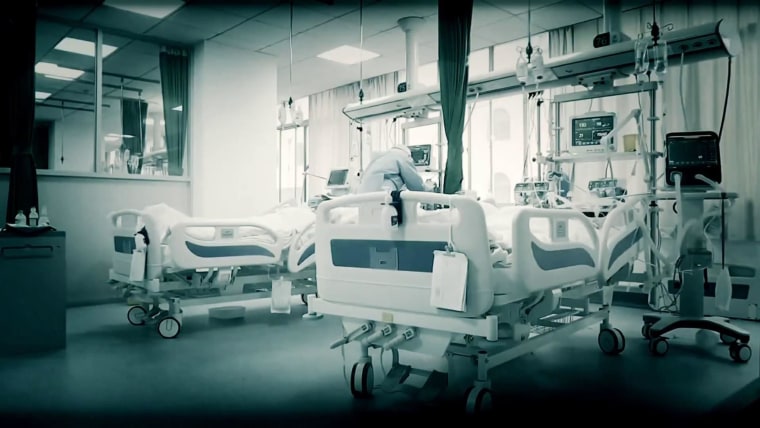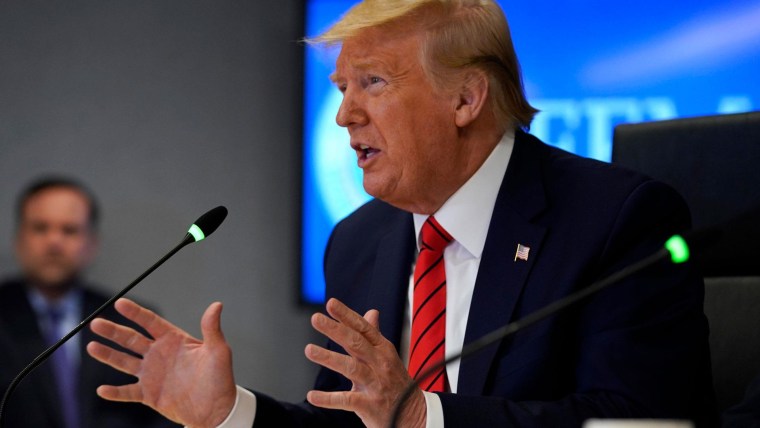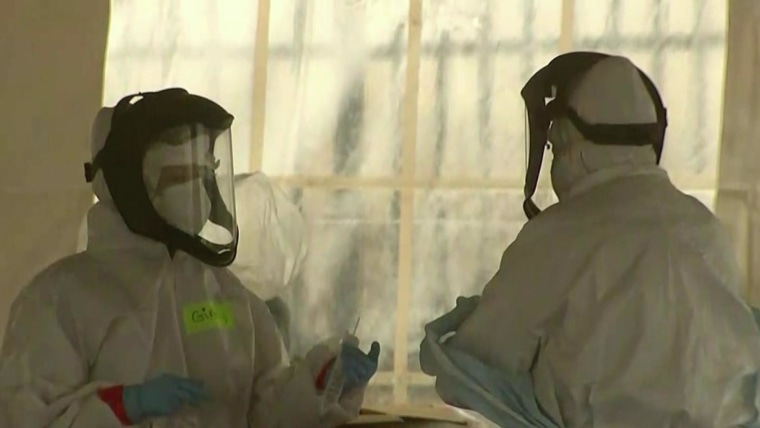Trump Administration’s Lack Of A Unified Coronavirus Strategy Will Cost Lives, A Dozen Experts Say
WASHINGTON — The Trump administration’s decision to let states chart their own responses to the coronavirus crisis rather than impose a national strategy will cost thousands of lives and is likely to result in an open-ended outbreak rolling across the country, a dozen public health experts told NBC News.
The only way to win what President Donald Trump has called a war against an “invisible enemy” is to establish a unified federal command, the experts insist — something Trump has yet to do. So far, the federal government hasn’t leveraged all its authority and influence to dramatically expand testing and tracing measures, ensure a sufficient supply of crucial medical equipment or require residents of all 50 states to stay at home.
Each day that passes without such a national strategy, the experts say, will raise the ultimate U.S. death toll from COVID-19, the disease associated with the virus. Right now, there aren’t enough tests and gear as states compete with one another to buy them on the open market. And there is very little ability to trace who has the virus and where it is spreading.
“This is a problem that we should be dealing with over the entire nation,” said William Haseltine, a biologist famed for his work on HIV and AIDS. “This is a national problem — it needs a national response.”
Without such a national plan of action carried out on a scale akin to the country’s mobilization during World War II, the experts say, some hospitals will continue to suffer shortages and the U.S. will lack the data needed to have a clear picture of where COVID-19 has spread, making it much harder to get the virus under control.
The Trump administration has declined to nationalize the medical logistics system and hasn’t executed a national testing strategy. Although the president likely lacks the legal authority to impose a national stay-at-home order, he has declined to urge each governor to do so. Seven states haven’t imposed one, including Texas.
The results are clear: Governors and doctors report critical shortages of gear, it remains very difficult to get tested for the virus, and some Americans still aren’t heeding guidance to keep away from others.
“This is not a partisan issue,” said Kenneth Bernard, a retired Navy rear admiral and biosecurity expert who served in the administrations of Presidents Bill Clinton and George W. Bush. “There needs to be a central command presence on this. There needs to be a person who can act as a focal point for tests, personal protective equipment and countermeasures — acquisition and distribution. Right now, it’s too fragmented and fractured, and that’s counterproductive, because the states are competing against the federal government for the same sources of materials.”
Trump continues to assert that the federal government’s role is supporting states, not leading.
“Massive amounts of medical supplies, even hospitals and medical centers, are being delivered directly to states and hospitals by the Federal Government,” he tweeted Thursday. “Some have insatiable appetites & are never satisfied (politics?). Remember, we are a backup for them.”
The decentralized approach is in stark contrast to South Korea’s actions. South Korea contained the outbreak by quickly implementing an aggressive national program of social distancing, testing and monitoring. Until testing is dramatically ramped up in the U.S., it will be extremely risky to go back to normal life, experts say. As of April 2, there have been a total of 1.2 million tests nationwide, according to the COVID Tracking Project, a fraction of what experts say is needed.
This report is based on interviews with and analyses from prominent public health experts and former senior U.S. officials who oversaw efforts to combat infectious diseases in administrations from both parties. These experts say a consensus has emerged in the public health field about what the federal government needs to do take control of the epidemic. The framework is based in part on similar efforts by other governments — including South Korea’s and Singapore’s — that appear to have “flattened the curve” of the virus for now.
Full coverage of the coronavirus outbreak
On Wednesday, an editorial in the New England Journal of Medicine exhorted the president to establish a unified effort.
“The president says we are at war with the coronavirus,” wrote Dr. Harvey Fineberg, president of the Institute of Medicine at Harvard University’s School of Public Health. “It’s a war we should fight to win.”
As of now, that isn’t happening, said Laurie Garrett, a public health expert and author of “The Coming Plague” and other books that warned of the growing danger posed by pandemics.
“In every way, in every aspect of the American outbreak or epidemic, what we lack is a strategic approach, so we’re utterly responsive,” she said. “The virus is beating us. It’s emerging and surprising us. We don’t know where it is. We don’t know where it’s going. We don’t know how it’s spreading. We don’t have interventions that follow a strategy.”
After initially having downplayed the severity of the coronavirus outbreak during a crucial February period of missed opportunities, Trump in recent weeks has ramped up the federal response. But when asked about the federal role, Trump and his advisers have described it as one of supporting the states.
On Wednesday, Surgeon General Jerome Adams said on NBC’s “TODAY” that White House coronavirus guidelines should be interpreted as a national stay-at-home order. But he also declined to demand that each governor follow it.
“We live in a nation that has a system of federalism, and the governors get to make the decision,” Adams said.
That philosophy has hampered the nation’s response to the pandemic in three crucial areas, experts say.
Let our news meet your inbox. The news and stories that matters, delivered weekday mornings.
A majority of the U.S. population is staying at home, and that drastic change in behavior appears to be slowing the spread of the virus, the experts say.
But a handful of states have resisted statewide directives, even though cities in some of those states have imposed their own. Florida’s governor issued a stay-at-home order Wednesday after days of pressure — and college students congregated for spring break on Florida’s beaches and then returned to their homes all around the nation.
As of Thursday, Arkansas, Iowa, Nebraska, North Dakota and South Dakota had no known orders in place. In Texas, Pennsylvania and Alabama, some cities have imposed their own restrictions, but there is no statewide rule.
Unacast, which tracks the movements of vast numbers of people via cellphone location data, has created a social distancing scoreboard, grading states on the extent to which residents are staying apart, based on changes from previous movement patterns. Fourteen states got C’s, another 14 got D’s and one, Wyoming, got an F.
When it comes to social distancing, delay means death, said Christopher Murray, director of the Institute for Health Metrics and Evaluation at the University of Washington, which has created a model the government is using.
The model predicts around 80,000 deaths if every state adopts social distancing until June 1, but each day that doesn’t happen increases the death toll, he said.
“Every day you wait, you can multiply those numbers out, so an extra week really adds quite a lot to the number of people who are eventually going to die,” Murray told MSNBC’s Rachel Maddow. “So every day counts.”
In a conference call with the nation’s governors, the president said, “Respirators, ventilators, all of the equipment — try getting it yourselves.”
There has been a mad scramble by states and localities to do so, even as a federal emergency stockpile is all but depleted. The federal government also has swooped in to buy supplies, with governors complaining that they have been outbid on occasions by federal agencies.
Charlie Baker, the Republican governor of Massachusetts, has complained about competing with the federal government for equipment. He became emotional about the issue during a news conference March 26, saying, “I stand here as someone who has had confirmed orders for millions of pieces of gear evaporate in front of us, and I can’t tell you how frustrating it is.”
What’s lacking, experts say, is any central coordination.
“A competition has ensued between states, and in the absence of a unified plan, the states that are affected the worst first have had to go it themselves,” said Beth Cameron, vice president for global biological policy and programs at the Nuclear Threat Initiative, who served in the administration of President Barack Obama as the senior director for global health security and biodefense on the National Security Council.
“States have had to basically develop their own system for responding while also working with the federal government when they can,” she said.
Download the NBC News app for full coverage and alerts about the coronavirus outbreak
Private entities are also pitching in. On Thursday, the New England Patriots’ team jet landed at Boston’s Logan International Airport stuffed to the gills with 1.2 million N95 masks it transported from China, according to The Wall Street Journal. Team owner Robert Kraft put up $2 million, the paper said, calling the operation “a window into the frenzied scramble by states to acquire life saving equipment needed to battle the coronavirus pandemic.”
Governors have described an increasingly chaotic situation.
“It’s just a madhouse out there,” Connecticut Gov. Ned Lamont, a Democrat, told NBC News. “Either people are overpromising or we get outbid at the last moment. Often by the feds, by the way. They’re often swooping in and coming in and purchasing.”
Experts have been urging Trump to do two things: make greater use of the Defense Production Act to seize control of the manufacturing process and appoint a military logistics expert to oversee the process.
On Thursday, Trump invoked the act for the second time to facilitate the production of badly needed ventilators. The order directs that materials to make ventilators be supplied to six companies: General Electric Co., Hill-Rom Holdings Inc., Medtronic Public Limited Co., ResMed Inc., Royal Philips N.V. and Vyaire Medical Inc.
A separate order called on 3M Co. to make more masks.
Some states and cities have already turned to retired officers.
Boston hired retired four-star Army Gen. Stanley McChrystal’s consulting firm to help coordinate the city’s response.
And hard-hit Washington brought on retired Navy Vice Adm. Raquel Cruz Bono, a former director of the Defense Health Agency, to oversee deployment of health care resources.
“What we really need are engineer-type people who know how to get things done and who know how to organize a large-scale response,” said Dr. Elias Zerhouni, who served as director of the National Institutes of Health in the administration of President George W. Bush. “What you hear right now are a lot of policies but not a lot of command and control.”
To get a clear picture of the outbreak and how to stem the spread, public health experts say a dramatic expansion of testing is required with a rapid processing time for results.
Same-day point-of-care diagnostic testing is needed to identify new cases, including among hospitalized patients, health care workers and others doing essential work, close contacts of confirmed cases and outpatients with symptoms, the experts say.
A widely cited new report from the conservative-leaning American Enterprise Institute think tank estimates that at least 750,000 tests a week would be “sufficient.” One of the authors of the report is Dr. Scott Gottlieb, who was head of the Food and Drug Administration under Trump from 2017 to 2019.
But the administration is still a long way off from that target.
“When we say all hands on deck, we are still not seeing that on testing,” Dr. Joseph Fair, an NBC News medical contributor, said Wednesday on “Meet the Press Daily.”
Along with widespread testing and swift sharing of the results of test data across the health system, so-called contact tracing is crucial to help isolate clusters of infection, experts said.
Contact tracing involves identifying a case of COVID-19, figuring out who else was in close contact with the patient, putting all those people under quarantine and then isolating the cases that developed from that group.
Former officials call it Public Health 101, and the labor-intensive approach has been used effectively in countries like South Korea that appear to have succeeded in preventing a larger outbreak.
Among the tools South Korea used was GPS location data from mobile phones — data that is widely used in the U.S. by private companies but is held at arm’s length from the government for privacy reasons. The data can trace an infected person’s movements in the past and monitor them going forward. In South Korea, those infected were required to install tracking apps on their phones.
“For South Korea, [contact tracing] is a huge part of the way that they’re keeping the case numbers down. We’re not talking about that. There’s been no discussion of it,” said Jeremy Konyndyk, a former senior official with the U.S. Agency for International Development who is now at the nonprofit Center for Global Development.
In the meantime, until widespread testing — and a testing strategy — is put in place, Americans trying to fight the virus will be flying blind, said Cameron of the Nuclear Threat Initiative.
“We definitely need a united plan for how we’re going to get to the massive rapid diagnostic testing we need to go back to a system of normalcy in this country,” she said.
“Without a nationalized plan for testing, we’re not going to be able to come out of the stay-at-home orders that we’re in right now.”
The White House didn’t immediately respond to a request for comment.
READ MORE HERE







